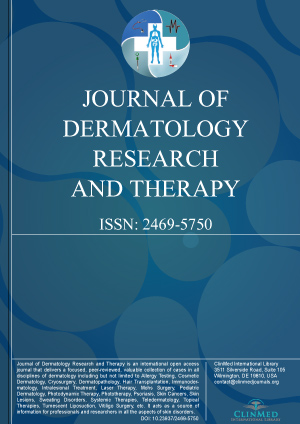Open Access DOI:10.23937/2469-5750/1510011
A case of Hemorrhagic Bullous Morphea
Hyeree Kim, Hei Sung Kim, Sang Hyun Cho and Jeong Deuk Lee
Article Type: Case Letter | First Published: December 01, 2015
Morphea, Bullous morphea, Hemorrhagic bullous morphea, Hemmorrhagicmorhea, Localized scleroderma, Bullous localized scleroderma. Bullous morphea is a rare form of localized scleroderma (morphea) characterized by bullae on or around an atrophic morphea plaque. The cause of bullae formation in morphea is multifactorial, with lymphatic obstruction from the sclerodermatous process being considered as the most likely cause....
Open Access DOI:10.23937/2469-5750/1510010
Lipoma on the Antitragus of the Ear
Hyeree Kim, Sang Hyun Cho, Jeong Deuk Lee and Hei Sung Kim
Article Type: Case Letter | First Published: November 30, 2015
A 31 year-old Korean woman presented with an asymptomatic, solitary, 0.5 cm-sized, skin-colored, firm, immovable mass on the antitragus of the left ear for one year (Figure 1A). She denied of previous trauma or infection. We initially suspected the mass as a dermatofibroma or nevus, because of its clinical manifestation. We performed a skin biopsy for confirmative diagnosis....
Open Access DOI:10.23937/2469-5750/1510009
Sun Sensitivity and Sunburns as Related to Cutaneous Melanoma among Populations of Spanish Descent: A Meta-Analysis
Leslie K Dennis, Stephanie G Lashway and Marvin E Langston
Article Type: Research Article | First Published: November 16, 2015
Few studies have examined sun sensitivity risk factors for cutaneous melanoma specifically in populations of Spanish descent. Previous searches were conducted in PUBMED for articles on melanoma and sun exposure through 2008. Over 300 articles were reviewed and relevant data was abstracted. These abstract forms were subsequently reviewed for studies in populations of Spanish descent. PUBMED was then examined for more recent studies of melanoma in populations of Spanish descent. Eight appropriate ...
Open Access DOI:10.23937/2469-5750/1510008
Evaluation of Zinc, Vitamin B12, Folic Acid and Iron Levels and Thyroid Functions in Patients with Chronic Telogen Effluvium
Pinar Ozuguz, Seval Dogruk Kacar, Ozlem Ekiz and Semsettin Karaca
Article Type: Research Article | First Published: September 21, 2015
Telogen effluvium (TE) is a hair disorder characterized by abrupt onset, diffuse, self-limited and excessive shedding of club hairs. The purpose of this study was to investigate serum zinc, vitamin B12 and folic acid levels as well as parameters of iron metabolism and thyroid functions in patients with chronic telogen effluvium (CTE) and compare the results to those of the controls. Methods: In this study, a total of 260 patients with CTE who were admitted to the outpatient dermatology clinic of...
Open Access DOI:10.23937/2469-5750/1510007
Pseudolymphoma Concomitant with Parvovirus B19 Infection
Loan Towersey, Maria Victoria Quaresma, Fred Bernardes Filho, Porphirio Jose Soares Filho, Ines K. Praxedes Baeta Neves, Andrea Rodriguez Cordovil Pires, Omar Lupi and Roderick Hay
Article Type: Correspondence | First Published: September 05, 2015
Jessner's lymphocytic infiltration of the skin (JLIS) is a skin condition of unknown an etiology characterized by erythematouspapules, plaques, and/or nodules located on the head, neck and upper back. Lesions usually are asymptomatic and resolve without scarring. JLIS can be similar in appearance to other benign lymphocytic infiltrates which include for instance a variant of lupus erythematosus (LE), in particular, tumid LE....
Open Access DOI:10.23937/2469-5750/1510006
Adjuvant Radiation Therapy is Feasible in Epidermolysis bullosa: A Case Report
Theodora A Koulis, Colleen Herring, Wendy Smith and Jon-Paul Voroney
Article Type: Case Report | First Published: September 02, 2015
A patient with a severe form of Epidermolysis Bullosa (EB) presented after an above knee amputation and groin dissection for a 57 cm Squamous Cell Sarcinoma (SCC) of the skin and underlying soft tissue of the right leg. Five of 19 nodes were involved with SCC metastases. Standard care would involve adjuvant Radiation Therapy (RT) but RT has historically been avoided in patients with EB who can have severe, non-healing cutaneous and mucosal morbidity from acute RT reactions. A radiation treatment...
Open Access DOI:10.23937/2469-5750/1510005
Explosive Cutaneous Mucormycosis Requiring Limb Amputation: Case Report and Literature Review
Vikas Patel, Stephen Squires, Tarek Shaath, Daniel R Hinthorn, Garth R Fraga and Rebecca Horvat
Article Type: Case Report | First Published: August 20, 2015
Mucormycosis is a potentially fatal systemic fungal infection. Risk factors include immunosuppression, organ transplantation, and diabetes mellitus. Rhinocerebral mucormycosis is the most common presentation in diabetic patients, whereas pulmonary mucormycosis is the most common presentation in patients with hematologic neoplasms. We describe an immunocompromised leukemia patient with painful ecchymotic plaques on the forearm. Punch biopsy demonstrated angioinvasive mucormycosis and culture grew...
Open Access DOI:10.23937/2469-5750/1510004
Vancomycin Hypersensitivity Reaction Presenting with Extensive Oral Ulcerations
Justin G. Hastings, Alok Vij and Anthony P. Fernandez
Article Type: Case Report | First Published: August 15, 2015
Vancomycin therapy is associated with several hypersensitivity reactions, the most common being the non-immunologically mediated 'red man syndrome'. Fever, rash, neutropenia, and other manifestations have also been variably associated with a vancomycin hypersensitivity reaction that is likely immunologically mediated. Here we report a 45-year old man who developed diffuse oral aphthous-like ulcers as the most prominent manifestation of vancomycin hypersensitivity reaction. We identified only two...
Open Access DOI:10.23937/2469-5750/1510003
Exogenous Ochronosis with Use of Low Potency Hydroquinone in A Caucasian Patient
Luke Maxfield and David A. Gaston
Article Type: Case Report | First Published: May 30, 2015
Exogenous ochronosis is a rare condition of paradoxical skin darkening seen with use of the skin lightening agent hydroquinone. Incidence has been highest in patients with darker skin types, prolonged use, and higher concentration treatment, but has been reported with low dose (2%) as well. Here we present a rare case of exogenous ochronosis, with resultant skin and nail hyperpigmentation, occurring in a Caucasian female using 3% hydroquinone cream over an eighteen-month period....

